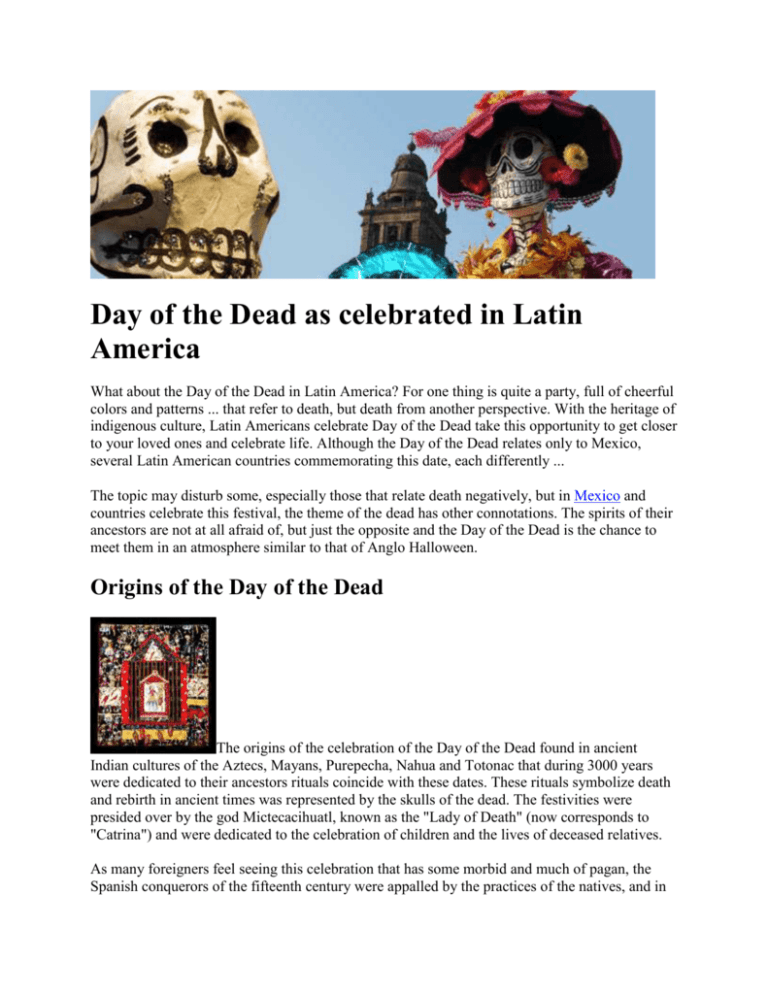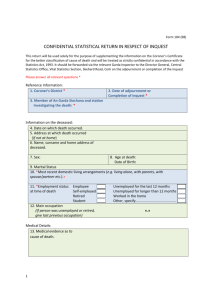Day of the Dead as celebrated in Latin America
advertisement

Day of the Dead as celebrated in Latin America What about the Day of the Dead in Latin America? For one thing is quite a party, full of cheerful colors and patterns ... that refer to death, but death from another perspective. With the heritage of indigenous culture, Latin Americans celebrate Day of the Dead take this opportunity to get closer to your loved ones and celebrate life. Although the Day of the Dead relates only to Mexico, several Latin American countries commemorating this date, each differently ... The topic may disturb some, especially those that relate death negatively, but in Mexico and countries celebrate this festival, the theme of the dead has other connotations. The spirits of their ancestors are not at all afraid of, but just the opposite and the Day of the Dead is the chance to meet them in an atmosphere similar to that of Anglo Halloween. Origins of the Day of the Dead The origins of the celebration of the Day of the Dead found in ancient Indian cultures of the Aztecs, Mayans, Purepecha, Nahua and Totonac that during 3000 years were dedicated to their ancestors rituals coincide with these dates. These rituals symbolize death and rebirth in ancient times was represented by the skulls of the dead. The festivities were presided over by the god Mictecacihuatl, known as the "Lady of Death" (now corresponds to "Catrina") and were dedicated to the celebration of children and the lives of deceased relatives. As many foreigners feel seeing this celebration that has some morbid and much of pagan, the Spanish conquerors of the fifteenth century were appalled by the practices of the natives, and in an attempt to convert Native Americans to Catholicism changed the date festival for the beginning of November; thus coincided with the Catholic holidays of All Saints Day and All Souls. How it is held On 1 and 2 November are distinct in two days the festivities. The one is the day returning souls of children and 2 adults souls. For both days the towns and cities are preparing a series of objects that are part of the ritual of every November. First are the skulls, which are represented in both crafts and Eve dishes. There are also skull-shaped masks and skulls to which are inscribed on the forehead the name of the deceased or living people as a joke. For anything spooky, the shapes of the objects are always rounded skulls show a wry smile and the food is usually fresh and the most awaited for children to which invites all kinds of goodies. The Day of the Dead is celebrated in many countries in Latin America and although all have the same meaning, each gives a personal touch. Mexico: the place indicated In Mexico , due to its proximity to the United States the feast of Halloween has become very popular, but it is the Day of the Dead in the main Mexican calendar. While in the villages and small towns the Day of the Dead is celebrated according to tradition, is also celebrated in cities with a modern touch. Usually the main point is when people go to the cemetery at night and decorate the graves, mainly using an orange flower called xempazuchitl. In homes is an altar in honor of deceased relatives, where they are placed photos, food and drink for the deceased on the night comes to remembering those tastes of his mundane life. The party in Mexico represents a number of elements of folklore that are only at this time of year. One is sweet bread called "pan de muerto" made with yeast that all tasted at dinner. They are also very traditional skulls made of sugar, which are given away to friends, with your name written on their foreheads. The skulls are among the gifts; rhyming verses are written by people, and so funny that narrate the encounter with the death of friends or people from politics. Marketers have taken advantage of this mortuary fever and perhaps because of them today is that cities also celebrate this traditional event. While the cities are very important celebrations, the most traditional are Patzcuaro and Oaxaca . Guatemala: a party with flowers In Guatemala it is believed that the blessed souls out of cemeteries and appear in places. Many leave home altars with a glass of water, a candle and a photograph of the deceased. Therefore, from days before the holiday, many decorate the graves or cleaned. Something very typical in Guatemala is dead flower, yellow, blooms only at this time, and the cypress, used for decorating homes and meeting places where private celebrations with family and friends include a large banquet. In this celebration are also some revelations and many believers who claim to have visions of the deceased or hear strange things that indicate their presence. Peru: entertaining the dead In rural Peruvians faithfully believe that the souls of the dead return to enjoy preparing altars in homes with objects that reflect some aspect of the life of the deceased. On the altars dedicated to the dead is located your photo, candles and flowers to the cemetery take the next day. The offerings for the deceased include meals enjoyed when the deceased was alive or something with significance to him. The custom is to leave offerings overnight, so that the dead can have time to enjoy them. The next day, we pray the food or drink that was set for the dead and once the sentence has been made all can enjoy the lunch special. The most moving moment occurs in the cemetery where the deceased relatives visit his grave and leave flowers to honor his memory. In urban areas of Peru , Day of the Dead is also celebrated, but a little different and instead of putting velarlas offerings for the night, people just put the offering on November 2. In the evening families go to the cemetery to visit their dead and leave flowers. This date is with joy and celebration shows that happiness in which family and friends gather at the deceased's house to remember him. During this little meeting regularly drink coffee while talking and remember things the deceased. Venezuela: the visit to the cemetery In Venezuela the procession goes inside. A somewhat forgotten tradition of Day of the Dead, the Venezuelans are taken this date to honor the dead and bring flowers to the cemetery. No major rites or parties, but a time to remember those who have gone in the privacy of home. It also is used to clean and decorate the graves. El Salvador: roots of tradition In El Salvador the Day of the Dead is celebrated on November 2. Although on a smaller scale that large festivals in other countries, Salvadorans continue the tradition of their roots and remember the dead on this day, but remember, it is a day that celebrates the lives of those who are still here. Nicaragua: sleeping with the dead Nicaraguans are taken very seriously this time and go far beyond any offering or tribute that anyone can do. The Day of the Dead in Nicaragua is celebrated at the cemetery and at night, something that at first seems scary and so very few people in the world are willing to spend. But Nicaraguans choose this way to honor their dead: spend a night with them. Yes, it is the time that the Nicaraguans go to the graveyard at night and fall asleep next to the graves of their relatives. Honduras, Costa Rica and Colombia: the religious festival It is in Honduras , Costa Rica and Colombia where believers attend pilgrimages cemeteries to bring love, ie, offering a symbol of gratitude for the favors granted by the saints for their loved ones. That's why the people in both countries comes on 1 November to cemeteries with crowns and palms to decorate graves and honor the departed. Also attends the church to pray for the dead and pray for the health and happiness of the living. Ecuador: a real feast The Day of the Dead is in Ecuador a real party. Families gather around a traditional meal: bread buses (like bread figures of children), accompanied with colada morada, a drink made from purple corn, blackberries and other fruits. Some indigenous communities still celebrate an ancient rite, the faithful encounter with the deceased during a meal on his grave. According to belief, the dead return each year, then you have to prepare your favorite dishes. The living await the guest has finished eating before serving. Often, they are left with only scraps ... Some regions also brings weapons and objects that were valuable, or invites him to play the Game of Piruruy (a dice game). According lucky pull, you can find out their needs or their reproaches. And thanks to this as a bone carved flame can also resolve disagreements ...






